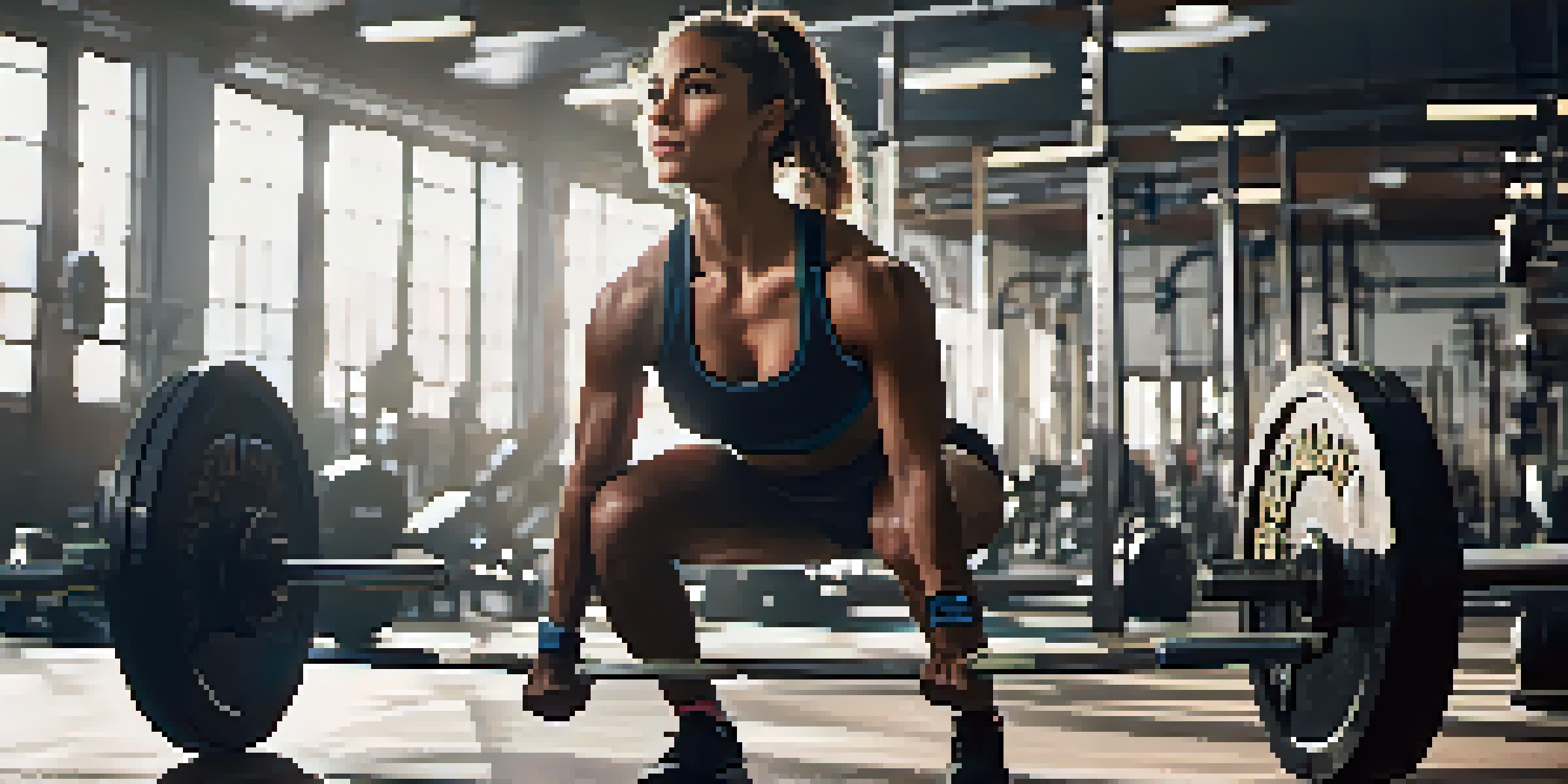Powerlifting for Women: Empowering Weight Loss Strategies

Understanding the Basics of Powerlifting for Weight Loss
Powerlifting is a strength sport that focuses on three main lifts: the squat, bench press, and deadlift. It's often misunderstood as just a way to get big muscles, but it can be an effective tool for weight loss, especially for women. By engaging in these compound movements, you’re not just lifting weights; you’re building a stronger metabolic rate.
Strength does not come from physical capacity. It comes from an indomitable will.
Many women shy away from powerlifting due to misconceptions about becoming bulky. However, the truth is that powerlifting helps in burning calories and improving overall body composition. It promotes lean muscle development, which is crucial for enhancing metabolism and aiding weight loss.
Incorporating powerlifting into your routine can create a more balanced workout, combining strength training with cardio for optimal results. Unlike traditional cardio, powerlifting can lead to more sustainable fat loss by increasing your muscle mass, which burns more calories even at rest. It's all about finding the right balance for your body!
The Science Behind Weight Loss and Muscle Gain
When it comes to weight loss, understanding the science is key. Weight loss fundamentally occurs when you burn more calories than you consume, also known as a caloric deficit. Powerlifting plays a significant role in this equation by increasing the number of calories you burn during and after workouts through muscle repair and growth.

The process of building muscle, known as hypertrophy, requires energy and ultimately leads to a higher resting metabolic rate. This means that even when you're not working out, your body is still burning more calories than it would if you had less muscle. This is one reason why powerlifting can be particularly effective for women looking to lose weight.
Powerlifting Aids Weight Loss
Engaging in powerlifting not only builds strength but also enhances metabolism, making it an effective strategy for weight loss.
Moreover, lifting heavier weights can stimulate hormones like testosterone and growth hormone, which are beneficial for muscle growth and fat loss. Understanding how these processes work can empower women to embrace strength training as a viable strategy for weight loss, moving past any fears of getting bulky.
Setting Realistic Goals in Powerlifting for Weight Loss
Setting achievable goals is crucial for maintaining motivation and tracking progress in any fitness journey. For women interested in powerlifting, this means defining what weight loss looks like for you, whether it's a specific number on the scale or a feeling of increased strength and energy. It's important to remember that weight loss isn't linear and can vary from week to week.
The only bad workout is the one that didn’t happen.
Instead of focusing solely on the scale, consider other indicators of progress, such as how your clothes fit or improvements in your lifting numbers. Celebrating small victories, like increasing your squat weight or completing more reps, can help keep you motivated. These milestones can be just as rewarding as the number on the scale.
Additionally, it’s essential to be patient with yourself. Weight loss takes time, and combining powerlifting with a balanced diet will yield better results than quick fixes. By setting realistic goals and celebrating your progress, you can create a sustainable approach to weight loss through powerlifting.
Creating a Powerlifting Routine for Women
Designing a powerlifting routine can be both exciting and daunting, especially for women new to the sport. A well-rounded program should include the three main lifts—squat, bench press, and deadlift—while also integrating accessory exercises like lunges or rows to enhance overall strength. Aim for two to three days of dedicated lifting each week to allow for recovery and adaptation.
It's also essential to balance your lifting with cardio and flexibility training. While powerlifting focuses on strength, incorporating some cardio can help with overall caloric burn and endurance. Activities like walking, cycling, or swimming can be great additions to your weekly routine without hindering muscle recovery.
Set Realistic Fitness Goals
Defining achievable goals and celebrating small victories can help maintain motivation in your powerlifting journey.
Lastly, consider consulting with a trainer who specializes in powerlifting to ensure your form is correct and to tailor your routine to your specific goals. They can help you navigate common pitfalls and provide guidance on progression, ensuring you stay safe and effective in your training.
Nutrition: Fueling Your Powerlifting Journey
Nutrition plays a pivotal role in any fitness regimen, and powerlifting is no exception. A balanced diet rich in protein, healthy fats, and complex carbohydrates is essential for fueling your workouts and aiding recovery. Protein is particularly important as it helps repair the muscle fibers broken down during lifting, contributing to muscle growth and weight loss.
Many women mistakenly think they need to eat less to lose weight, but in reality, fueling your body properly is vital. This could mean adjusting your caloric intake to ensure you’re in a slight deficit while still providing enough energy for your workouts. Foods like chicken, fish, quinoa, and vegetables should become staples in your diet.
Additionally, staying hydrated is often overlooked but is crucial in optimizing performance and recovery. Make sure to drink plenty of water before, during, and after your workouts. By focusing on nutrition alongside your powerlifting efforts, you can maximize your weight loss results and feel your best.
Overcoming Common Barriers to Powerlifting
Many women face barriers when it comes to starting powerlifting, whether it’s fear of injury, intimidation in the gym, or uncertainty about where to begin. It’s important to acknowledge these fears and realize that they are common among beginners. The key is to educate yourself about proper techniques and seek support from the community.
Finding a supportive environment can make all the difference. Consider joining a powerlifting club or community where you can learn from experienced lifters who can provide guidance and encouragement. Online forums and social media groups can also offer a wealth of information and motivation to push through initial hesitations.
Nutrition Fuels Your Lifts
A balanced diet rich in protein, healthy fats, and complex carbohydrates is crucial for supporting powerlifting performance and recovery.
Lastly, remember that everyone starts somewhere. Focus on your own journey and progress rather than comparing yourself to others. Embrace the learning curve, and with time and practice, you’ll grow more comfortable and confident in your powerlifting abilities.
Celebrating Your Progress and Staying Motivated
Celebrating progress is essential in any fitness journey, especially in powerlifting. Whether it's hitting a new personal record or simply feeling stronger in your daily activities, acknowledging these achievements can help keep you motivated. Consider keeping a journal to track your lifts, nutrition, and milestones, providing a tangible reminder of how far you've come.
Additionally, setting new challenges can reignite your passion for powerlifting. As you progress, think about participating in local competitions or setting personal challenges that push your limits. This not only adds excitement but also connects you with other like-minded individuals who share your goals.

Finally, don’t forget to reflect on your journey regularly. Understanding the positive changes powerlifting has brought to your life, whether physical, mental, or emotional, can help you stay focused on your goals. Embrace the journey and celebrate every step, no matter how small, as you work towards empowering yourself through powerlifting.